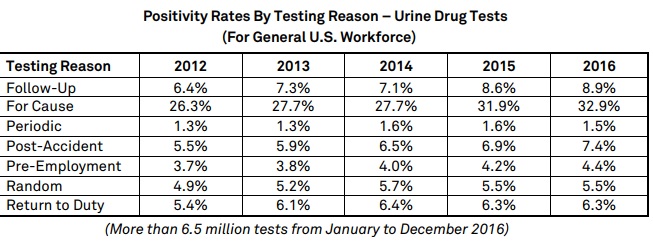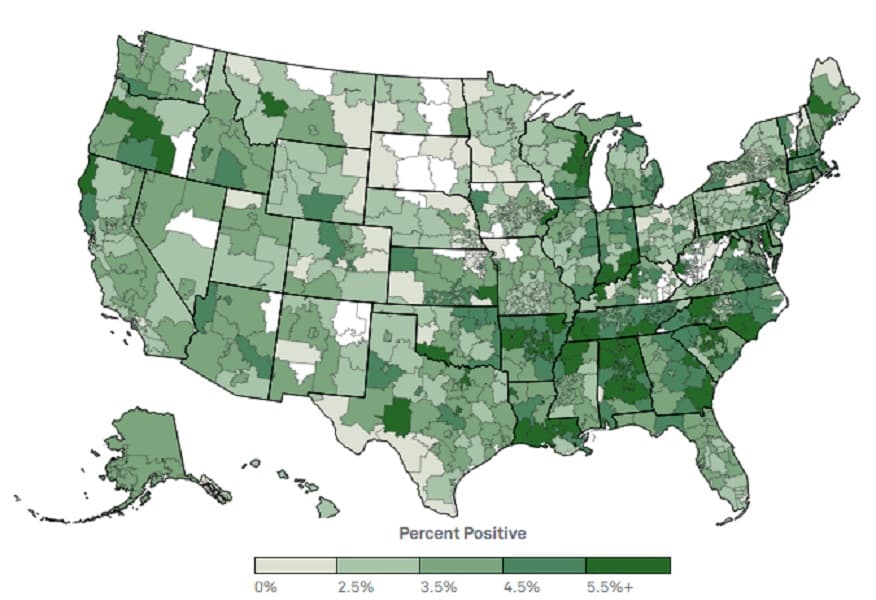Just over 1 in 25 American workers tested positive for drugs last year. It’s the highest rate in a dozen years, says Quest Diagnostics.
The Quest Diagnostics Drug Testing Index, which details the results of more than 10 million workforce drug tests, shows cocaine, marijuana and methamphetamine use was up across the nation. Heroin use, after four years of increase, was unchanged, while prescription opiate use, already low, declined further.
The Quest report breaks out the results for workers in safety-sensitive jobs where periodic testing is mandated by federal rules, and also reports results for the general workforce. Looking at just the general workforce results, just under one in 20 tested workers were found to be positive for drugs.
“This year’s findings are remarkable because they show increased rates of drug positivity for the most common illicit drugs across virtually all drug test specimen types and in all testing populations,” said Barry Sample, PhD, senior director, science and technology, Quest Diagnostics Employer Solutions.
However, except for marijuana, drugs were found in only a small, even tiny percentage of the tested workers:
- Cocaine was found in 0.28% of the nearly 9 million workplace urine samples.
- Prescription opiates were found in fewer than 1% of the samples: hydrocodone (0.81%), hydromorphone (0.59%), and oxycodones (0.69%).
- Heroin was found in 0.028% of the samples.
- Methamphetamines were found in 0.42% of the samples, a 75% increase since 2013.
Marijuana was most common drug
Marijuana was the most commonly detected drug, Quest said. It was found in 2.5% of the 6.5 million general workforce samples. Among federally mandated safety-sensitive workers — among these are pilots, bus and truck drivers, and workers in nuclear power plants — 0.78% of the 2.2 million tests found marijuana.
In oral fluid testing, which detects recent drug use, marijuana positivity increased nearly 75%, from 5.1% in 2013 to 8.9% in 2016 in the general U.S. workforce, Quest said. This increase was especially pronounced in Colorado and Washington, the first states to legalize recreational marijuana.
“We have been tracking the trends in marijuana positivity in states that have passed medical and recreational marijuana use statutes for several years now. 2016 is the first year since Colorado and Washington approved recreational use that the rates of year-over-year change were sharply higher than the national average,” said Sample.
Testing reasons and the new OSHA rule
Quest’s report says almost a third of the general workforce urine tests that came back positive were “for cause,” meaning the employer had evidence of drug use or a reasonable suspicion the employee was under the influence. Another 7.4% of the tests were ordered after a workplace accident.
 As the chart shows, in both cases the percentages have been rising annually since 2012. The post-accident positives have increased by 35% over the four year period. The Quest report doesn’t speculate why that is, but it could be that employers are ordering more tests.
As the chart shows, in both cases the percentages have been rising annually since 2012. The post-accident positives have increased by 35% over the four year period. The Quest report doesn’t speculate why that is, but it could be that employers are ordering more tests.
An OSHA rule that went into effect last year is likely to curtail routine post-accident testing, according to an analysis by Littler Mendelson attorneys. OSHA’s rule on the reporting of workplace injuries and illnesses requires employers to “establish a ‘reasonable procedure’ for employees to report work-related injuries and illnesses promptly and accurately.” Where post accident drug testing would deter an employee from making a report, the OSHA rule discourages the testing.
